While in Montefalco to attend the Anteprime Montefalco June 16-18, 2025, we visited 14 producers at their properties to taste their wines. Given we were only there three days, that’s about five producers a day! We’re providing a short summary of the wineries we visited below with links to their websites. Reservations are recommended for all winery visits. Many are members of the designated wine tourism route, “Strada del Sagrantino” whose website provides helpful information for planning your trip. The Sagrantino Route
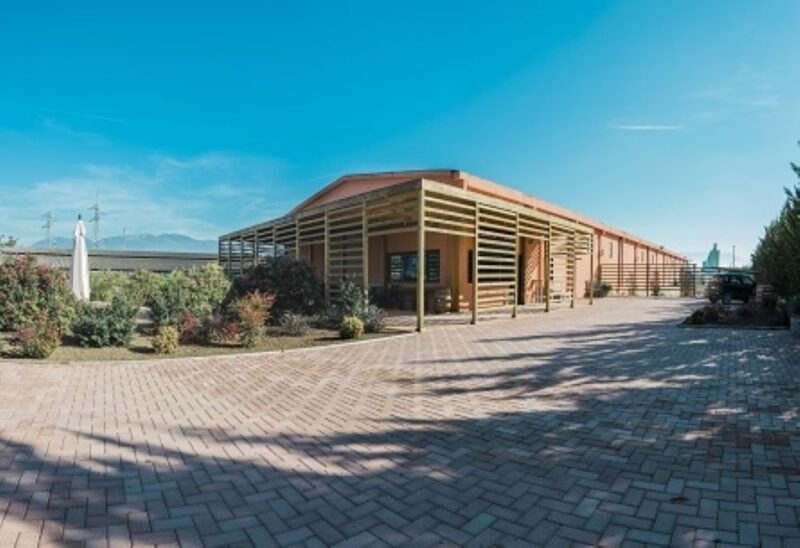
Benedetti & Grigi- Photo: La Strada del Sagrantino The Sagrantino Route
Benedetti & Grigi Benedetti&Grigi
The owners of this winery (established 2015) refer to it as “a marriage of grapes and grains” Umberto Benedetti was a long-time grape grower, and Daniele Grigi produced grains and cereals. Winemaker Matteo Basile previously worked with Frescobaldi. He led us through our tasting.
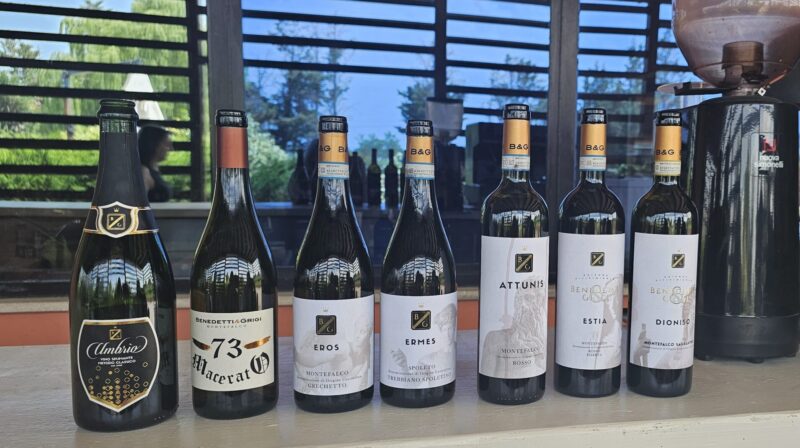
Wines we recommend:
Sparkling Grechetto, 100% Grechetto, aged 22 months in bottles, pas dosé. Toasty nose with bright lemon-scone on palate
Eros Montefalco Bianco 2024, 95% Grechetto, 5% Chardonnay tropical and stone fruit with hint of fresh picked peas and beans
Ermes Trebbiano Spoletino 2024, a high acid white wine from 100% Trebbiano Spoletino grapes. white peach notes with tropical undertones.
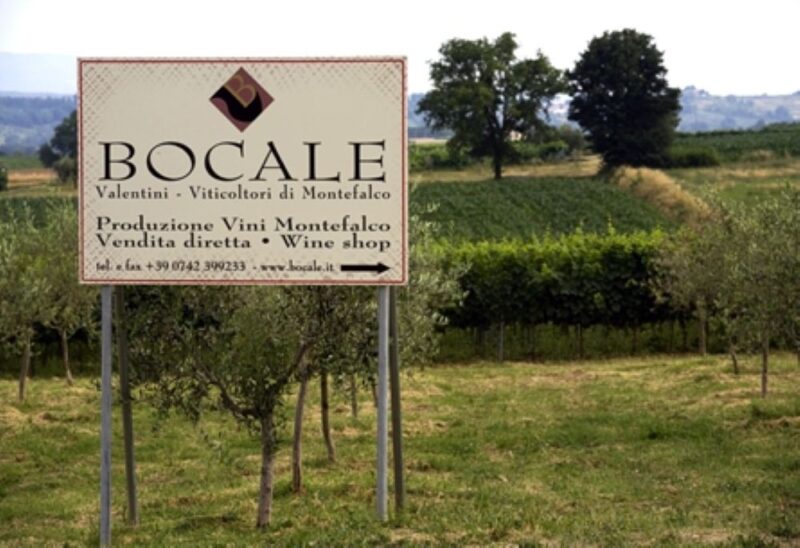
Entrance to Bocale di Valentini Photo: La Strada del Sagrantino The Sagrantino Route.
Bocale Valentini Bocale Valentini
The Valentini family settled in Montefalco in 1920 and dedicated itself to agriculture, including vine growing and olive production, on the slopes of the Alzatura hill. Giuseppe Valentini started making wine in in the 1950s, selling it locally in two-liter demi-johns, known locally as “Bocale.” The name stuck. In the 1990s, the family replanted its vines and began bottling its wines. Valentino Valentini represents the third generation overseeing the family winery.

Wines we recommend:
Trebbiano Spoletino 2024, nice acidity and minerality with notes of pineapple and yellow apple
Montefalco Rosso DOC 2022, 70% Sangiovese, 15% Sagrantino, 10% Merlot, 5% Colorino, strawberry and spice with balsamic notes. Aged 12 months in barrel and at least 6 in bottle
Ennio Sagrantino 2019. notes of dark/dried plum, cacao and wood.
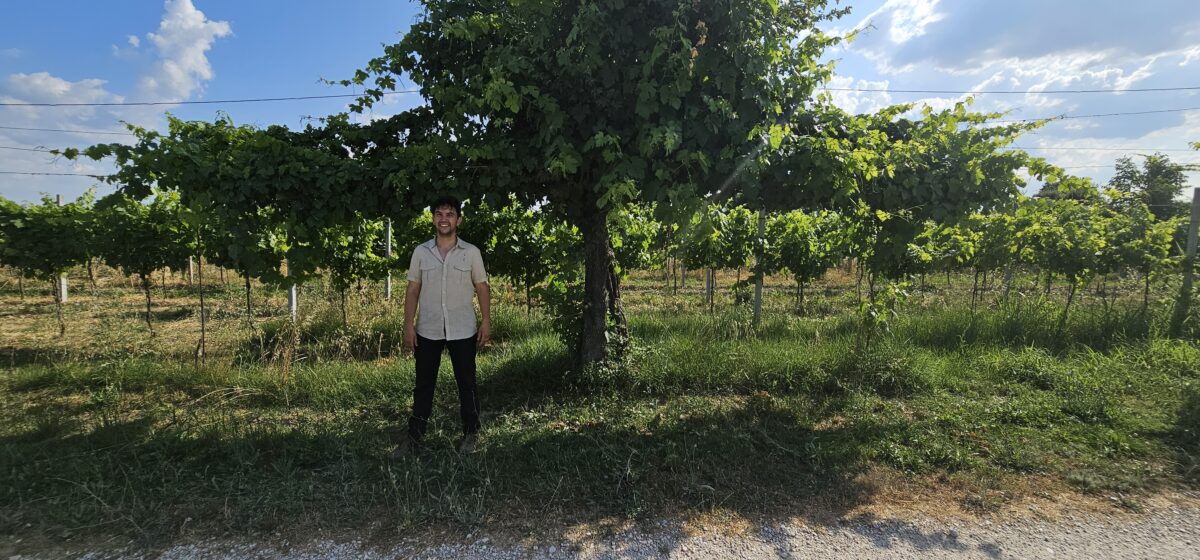
Fabio Conti stands in front of a tree with married vines Photo: Melanie Young
Cantina de Conti De Conti Winery and Farm
This small winery was founded in 1982 by Battista Conti who specialized in the cultivation of old vine Trebbiano Spoletino. His grandson, Fabio, took us out to the vineyards to see an example of Conti’s 150-year-old “married vines,” entwined around the large trunk of a tree. Married vines were a tradition prior to trellising systems and there are very few examples left. In addition to Trebbiano Spoletino vines, Cantina Conti also cultivates olives, lavender, and sunflowers.
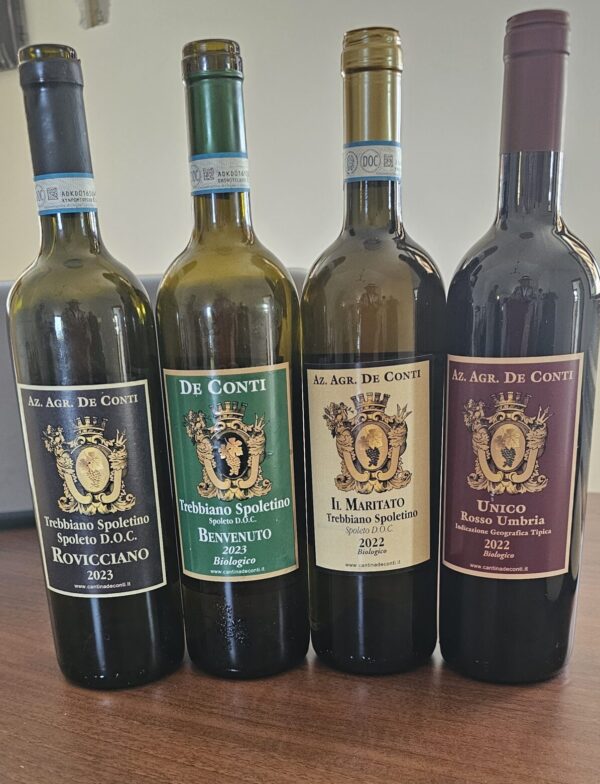
Wines we recommend:
Benvenuto Trebbiano Spoletino 2023, produced from 100-year-old vines and had a deep gold hue and notes of pineapple, lychee and fresh peas
Maritato Trebbiano Spolentino 2022, produced from the 150-year-old married vines and had notes of apricot, lychee and orange zest.
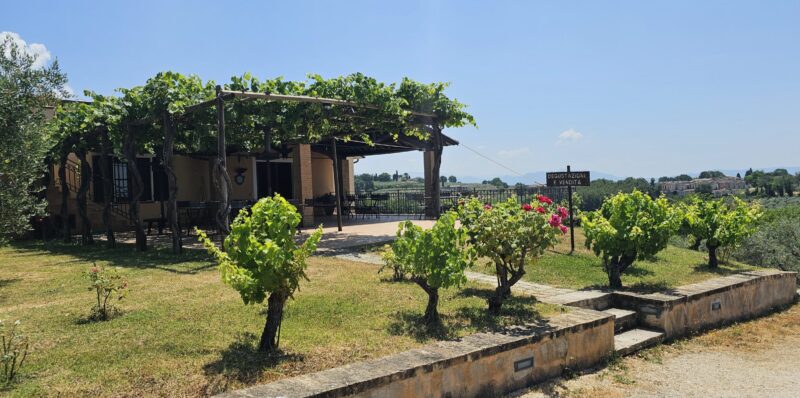
Cantina Colle Ciocco Photo: Melanie Young
Cantina Colle Ciocco The Colle Ciocco Winery – Azienda Agricola Spacchetti
The Spachetti family has been making wine at Cantina Colle Ciocco since the 1879 and is one of the oldest winemaking families in Montefalco. The modern winery was established in 1935 by Settimio Spacchetti. Today it is run by his sons Lamberto and Eliseo. Like many of the producers, the family also cultivates olives and produces exceptional olive oil. They are now making an ancestral method Tempestivo Trebbiano Spoletino Pet’Nat which was light and lemony. Our guided tasting conducted by Matteo Spachetti (sixth generation) took us through different vintages of both the family’s Trebbiano Spoletino and Sagrantino Montefalco wines was thoughtfully paired with different prepared dishes.
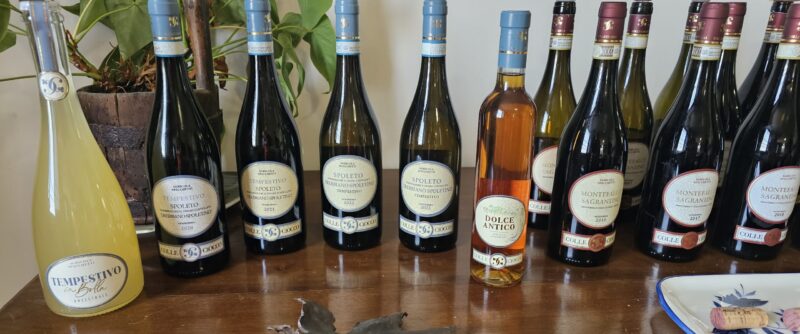
Wines and pairings we tried and recommend:
Tempestivo Trebbiano Spoletino 2021, an aromatic dry white with notes of grapefruit and lychee that paired beautiful with our white bean salad.
Montefalco Sagrantino 2019 (currently in market) with summer black truffle crème and gorgonzola en croute. We also recommend the 2020 vintage which has dark blue/black berry notes with firm tannins.
Montefalco Sagrantino Passito. We tasted four vintages ranging from 2015 to 2019, all silky and sublime, paired with chicken liver mousse and also dark chocolate.
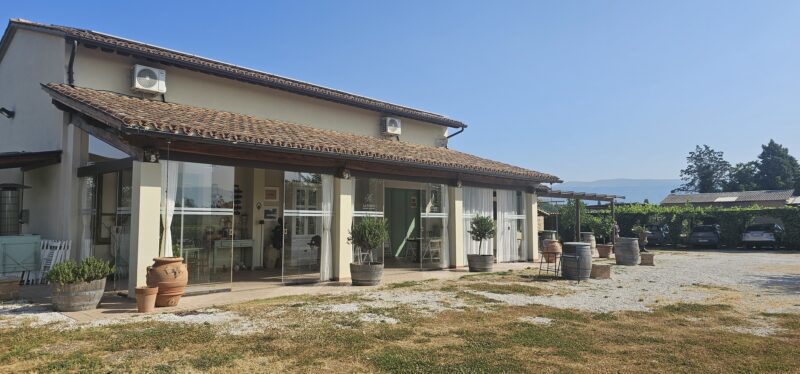
La Fonte entrance Photo: Melanie Young
Azienda Agricola La Fonte La Fonte Azienda Agricola
This small family-run organic winery, operated by a sister and brother, Giulia and Francesco Marinucci, produces elegant small production wines. Francesco studied winemaking in Burgundy. The family started as growers and established their winery in 2015. When we visited, plans were underway for a tenth anniversary dinner celebration in the vineyards. La Fonte now comprises seven hectares with four under vine. The rest is allocated to saffron and olives (their olive oil was exceptional). La Fonte has a small agritourism on the property and another near La Strada del Sagrantino bicycle trail.
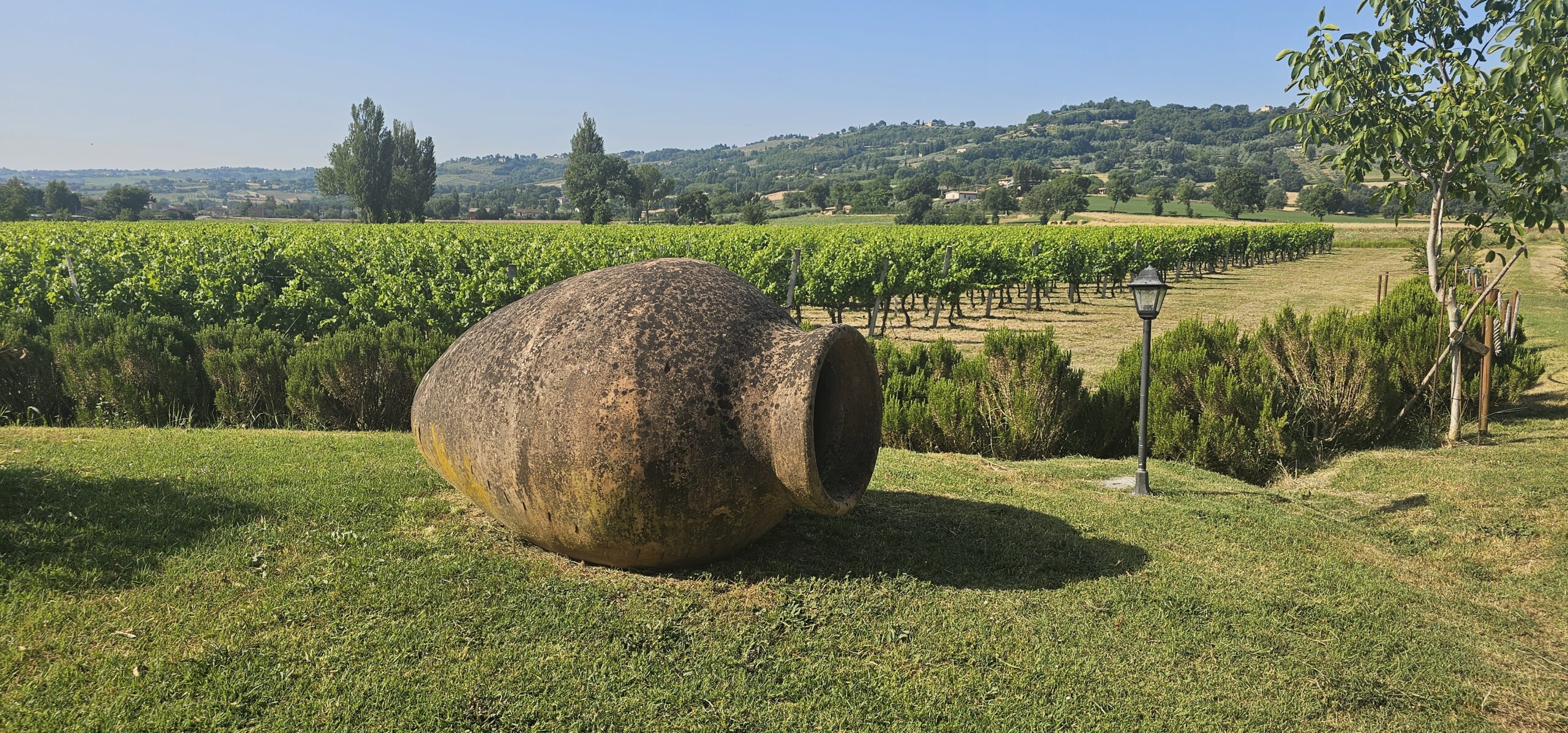
Wines we recommend:
Fantastique Trebbiano Spoletino IGT Umbria 2024. This is a fruitier style of Spoletino with pleasant minerality and acidity. The first release of this wine in 2023 was just 60 bottles.
Collefreddo Montefalco Rosso DOC 2020,
60% Sangiovese, 20% Sagrantino, 10% Merlot. The juice is all vinified separately before blending and aging in barrique. The Merlot delivers a bonus of soft red fruit in this wine.
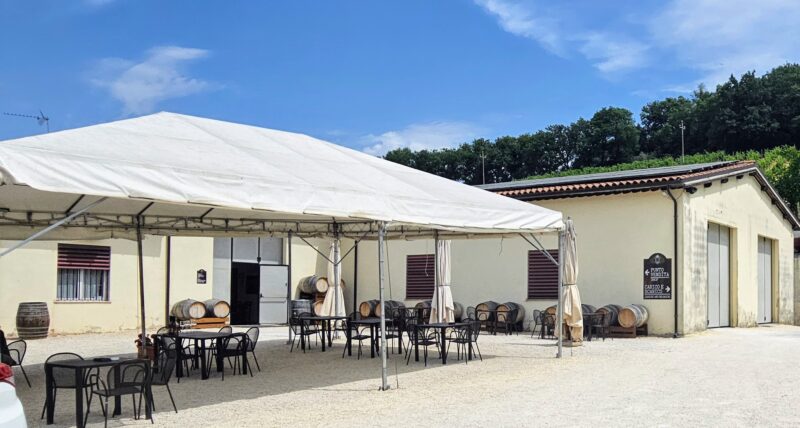
Cantina La Veneranda Photo: Melanie YoungLa Veneranda www.laveneranda.com
The Veneranda is a small winery, with an ancient history dating back to 1568 when the Moncelli family bought and cultivated some land in Montefalco. Through marriages the winery grew and in 1827 the property passed into the hands of Maria Aloisa Moncelli, a lady “of great culture and respect” which inspired the winery’s name “Veneranda” (respected). Today the winery is run by her descendants Eleonora Alessandrelli and Anna Rita Scarca. Production is 60,000 bottles with 20 hectares of vineyards in the subzone of Montepennino, which has clay and gravel soils. The family produces beautiful small production wines. Which we tasted with their excellent house made salumi, aged Pecorino cheeses, honeys, and jam.
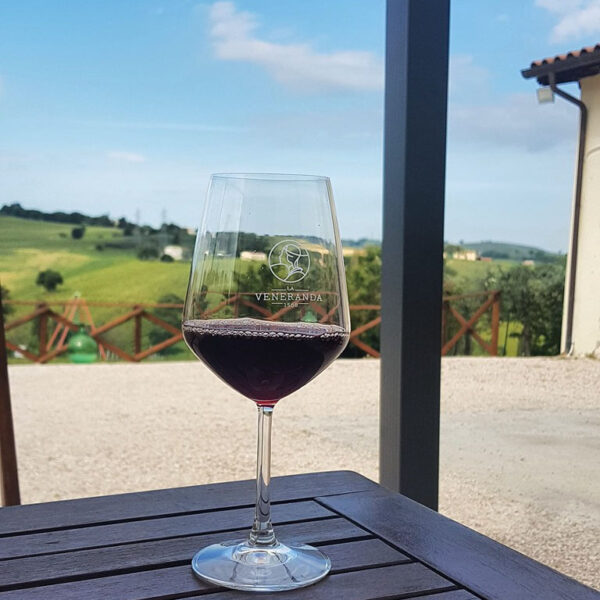
Wines we recommend:
Montefalco DOC Grechetto 2024 cru wine made from 25-year-olds vines, aged in stainless. Straightforward- intense mineral nose with notes of lemongrass, ginestra, golden apple and pear.
Federico II Rosato di Sagrantino IGT 2024. This coppery color rose is made from free run juice, with no skin maceration and delivers notes of tart apple and wild strawberries The Moncelli family was one of the first in the area to produce a Rosato di Sagrantino.
Montefalco Sagrantino DOCG 2020. Produced from vines averaging 35-40 years. The wine is aged 36 months in large oak casks and then another 4 months in bottle before release. This is a savory bold wine with notes of chicory coffee, vanilla, dried cherry, wild red berry and black plum. Firm tannins.

Vineyards at Le Cimate Photo: Melanie Young
Le Cimate www.lecimate.it
Three generations of the Bartoloni family have worked in agriculture since 1800 and own a total of 170 hectares of land including 23 under vine. The remainder are dedicated to the cultivation of olives and hazelnuts. The modern winery was established in 2011 initially with eleven hectares acquired in 1992. Our visit with Paolo Bartoloni (third generation) included tastings of wine, olive oil and gianduja (homemade chocolate hazelnut spread) on fresh bread. Le Cimate means “the Peak,” and all the wines were in “peak form” when we tasted them.
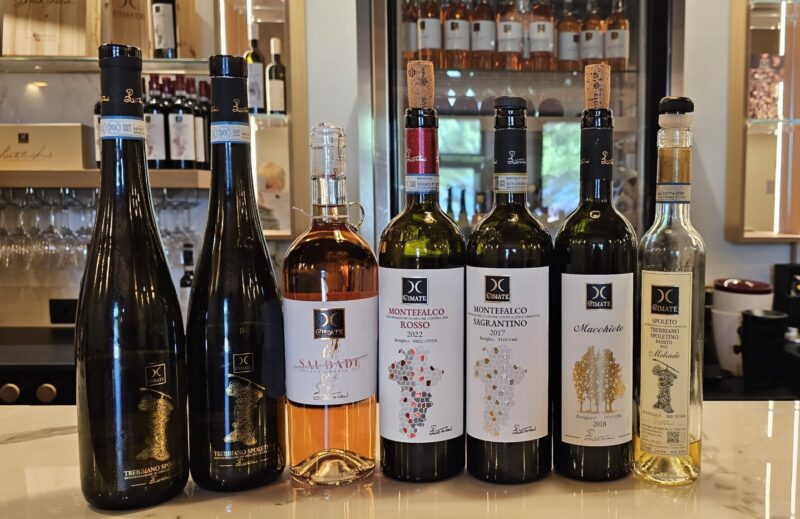
Wines we recommend:
Montefalco Rosso DOC 2022. An interesting blend of 60% Sangiovese 20% Sagrantino, 10% Refosco and 10% Tannat. This wine delivered lush notes of dark red berries and violets and was silky and balanced. The 2022 is the 7th vintage. Elegant with very balanced fruit.
Montefalco Sagrantino DOCG 2017. Aged in in small-medium-large casks for 30 months and then 3 years in bottle. Notes of dark cherry, cacao, rosemary and balsam.
Meliade Trebbiano Spoletino 2022. The name means “sweet like the honey” and this wine looks and tastes like a very ripe apricot. Grapes are air-dried for 50 days and then aged in small acacia oak barrels for one year and one more year in bottle. This is truly “nectar from the vine.”

Lungarotti- Photo: La Strada del Sagrantino The Sagrantino Route.
Lungarotti www.lungarotti.it
This expansive winery (2.2 million bottles produced) was founded by Giorgio Lungarotti, who is considered a pioneer of modern winemaking in Montefalco. Giorgio’s daughter, Chiara Lungarotti, oversees the estate with her sister and mother and has been a guest on The Connected Table LIVE. She describes Montefalco Sagrantino in this way: “Sagrantino is like a wild horse that needs to be tamed with the correct viticultural practices so that the wine is harmonious and balanced.” We’ve had the pleasure of visiting Lungarotti’s Montefalco estate a few times and look forward to visiting their estate in Torgiano next time we visit Umbria.

Wines we recommend:
Montefalco Rosso DOC 2022. 65% Sangiovese, 20% Sagrantino, 15% Merlot. Notes of black plum, anise and pepper with a long finish.
Ibio Rosso 2021. 100% Sagrantino (non DOCG). Dark plum, black cherry and earthy, mushroom notes.
Sagrantino di Montefalco DOCG 2020. 50% barrique, 50% large barrel. 2-3 years in bottle. Dark plum, earthy, pine forest notes.
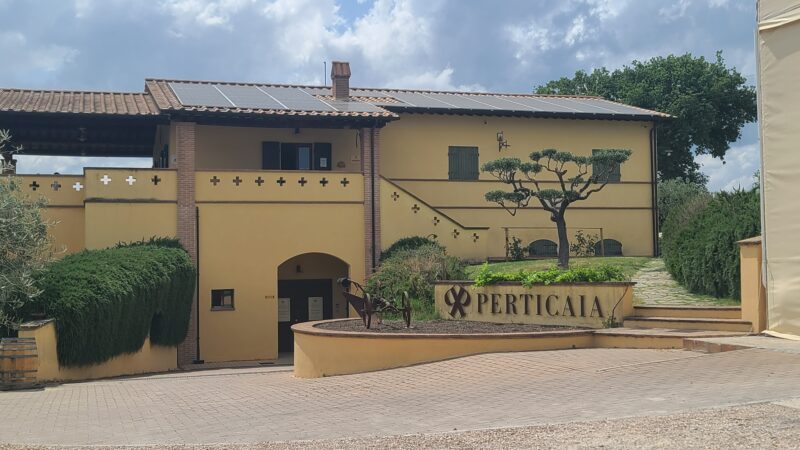
Perticaia courtyard Photo: David Ransom
Perticaia www.perticaia.it
Perticaia is Umbrian dialect for “plow.” Indeed, farming is the main focus of this winery which started with sheep and transitioned into wine. Today, Perticaia has 34 hectares of vineyards and 250 olive trees in in Casale di Montefalco. Perticaia has an exclusive clonal selection for Trebbiano Spoletino, the winery’s main focus. Both the Montefalco Rosso and Montefalco Sagrantino DOCG were classic and elegant. The winery is owned by the Becca family, entrepreneurs from Luxembourg who also have a luxury resort, Castello di Gallano, close to the winery.
Wines we recommend:
Trebbiano Spoletino 2024. Aged six months in stainless and 3 months in bottle, had pleasant lemon-marigold-apple, crisp acidity and nice sapidity.
Del Posto Trebbiano Spoletino DOC 2023. Aging 12 months on lees presents a richer style wine. Mineral driven, lots of fruit, melon, with nice acidity.
Sagrantino di Montefalco DOCG. We tasted four vintages, the 2010, 2018, 2020 and a 2022-barrel sample. The standout was the 2018 vintage of Sagrantino di Montefalco, aged 36 months in large French barrels. This wine had firm tannins and notes of dark red and black plum, moss and pine and showed long aging potential.
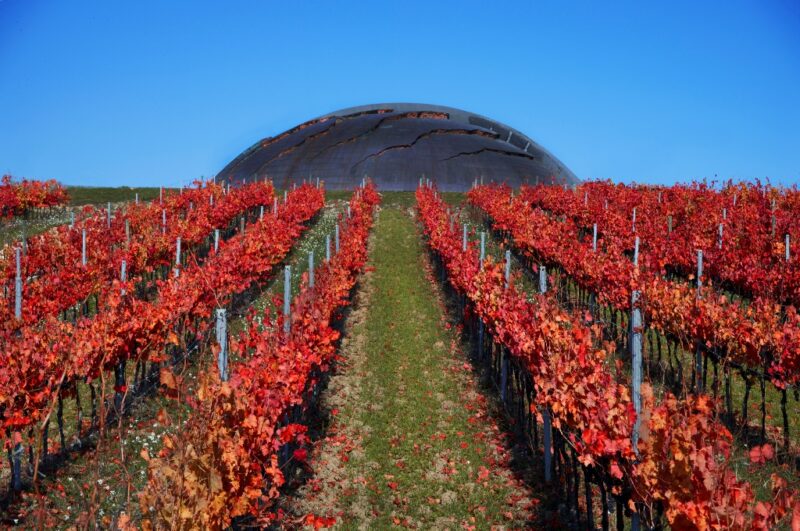
Carapace of Tenuta Castelbuono – photo provided by Tenuta Lunelli
Tenuta Castelbuono www.tenutelunelli.it
Envision that a large copper flying saucer has landed amid a vast land of vines and what you see is the dome. There you have The Carapace of Tenuta Castelbuono, a collaboration between the Lunelli family and their longtime friend and architect, Arnaldo Pomodoro. The Carapace dome itself took six years to build. Inside there is a 360-degree view and ample room for tastings and events. The name “Carapace” means “encased,” much like the hard shell of a tortoise, in this case a coppery one. Sculptural details continue down to the underground cellar.
The Lunelli family’s signature wine brand is Ferrari, the renowned sparkling wine of TrentoDOC established in the 1950s. The family purchased 30 hectares within the communes of Bevagna and Montefalco in 2001, drawn to the region for its Sagrantino wines. Their first Montefalco Rosso was launched in 2003 and then in 2004, a Montefalco Sagrantino. Tenuta Castelbuono has been certified organic since 2014. In 2015, the family hired Luca d’Attoma, a consulting enologist who is well-regarded for his work with Cabernet Sauvignon. Alexander Lunelli, grandson of founder, Giorgio Lunello, told us d’Attoma has helped define the signature of his family’s Montefalco red wines.
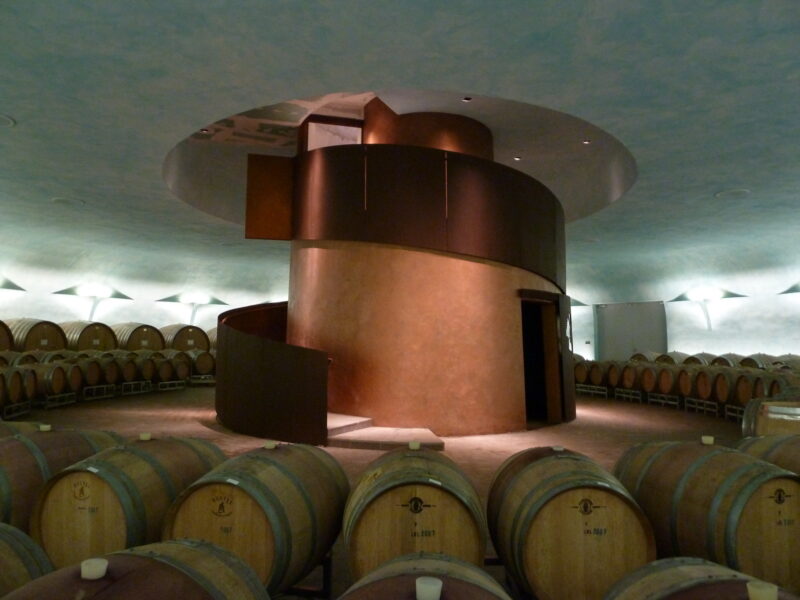
Tenuta Castelbuono underground cellar
Wines we recommend:
Carapace Sagrantino Montefalco DOCG. Lush and silky thanks to partial vinification in amphora.
Carapace Lunga Alteza. The family’s version of a “Riserva” Sagrantino even though this exact term is not allowed. The name means “long wait,” a nod to the wine’s aging for seven years (3 in tank, 3 in oak barrels, 1 in bottle). Soft elegant with notes of balsam and wood.
Lampante Riserva 2021. The name is a reference to a red lightening sculpture artwork at entrance to winery. 70% Sangiovese, 15% Sagrantino, 15% Cabernet and Merlot. Notes of dark red berries.
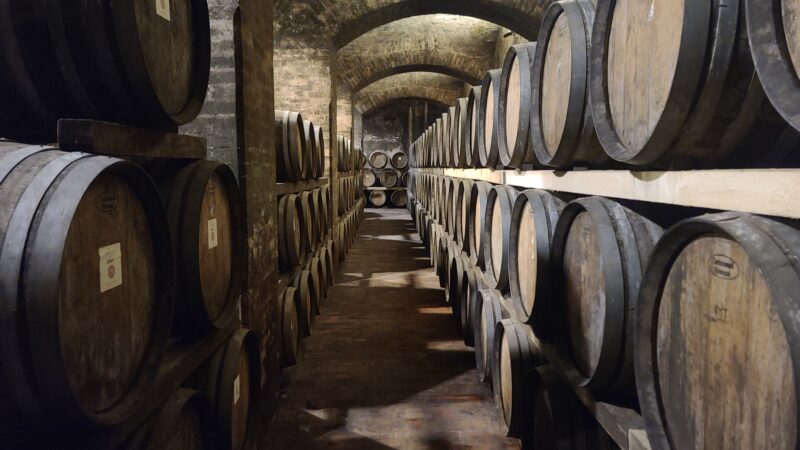
Historic cellars at Scacciodiavoli Photo: David Ransom
Cantina Scacciadiavoli“Chase out the devil” is the meaning of the word “Scacciadiavoli,” here referencing an ancient story dating to the 14th century about a woman possessed by the Devil who was exorcised from his demonic spirit by drinking the local wine. Scacciadiavoli’s history is as storied as the wines are outstanding. In 1884: Ugo Boncompani Ludovisi, prince of Piombino, built the winery inspired by the chateaux of France. At that it time was considered “cutting- edge” to local Umbrians. The estate was passed down through generations of three family owners – Ugo Boncompagni, Vittorio Rolandi Ricci, and the Pambuffetti family.
Since the 1950s, Cantina Scacciadiavoli has been under the stewardship of the Pambuffetti family, who have ushered the winery into the modern era while retaining the winery’s original design and historic detail, including its multi-level gravity-fed fermentation system leading to its underground cellar. The family has also ensured its legacy through pragmatic upgrades when necessary.
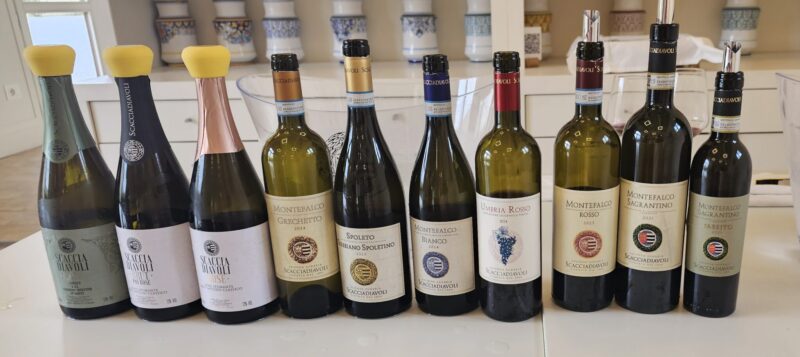 Production is 200,000 bottles with metodo classico sparkling wine a strong point.
Production is 200,000 bottles with metodo classico sparkling wine a strong point.
Wines we recommend:
Pas Dosé 2021 blended from 50% Trebbiano Spoletino and 50% Sagrantino. Refreshing and versatile with food.
Pas Dosé Rosé 2022 made from 100% Sagrantino. Slighty more floral and fruit.
Montefalco Bianco DOC 2024 made with 50% Trebbiano, 30% Grechetto, 30% Chardonnay. Notes of tropical and stone fruits and white flowers.
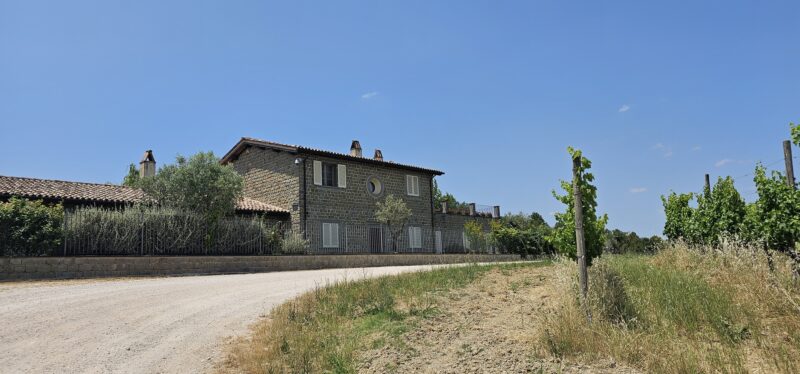
Tenuta Bellafonte Photo: Melanie Young
Tenuta Bellafonte Bellafonte Estate – Tenuta Bellafonte
Tenuta Bellafonte was founded by Peter Heilbein, a man of German ancestry who grew up in Italy with a passion for Umbria. This remote winery near Bevagna includes 25 hectares with 10 under vine and the rest allotted to olive trees and natural forests. Sitting with Heilbein and enjoying a homemade lunch with is wines was idyllic, a kind “pinch me that we are actually working” moment. The winery has a rentable villa on-site.
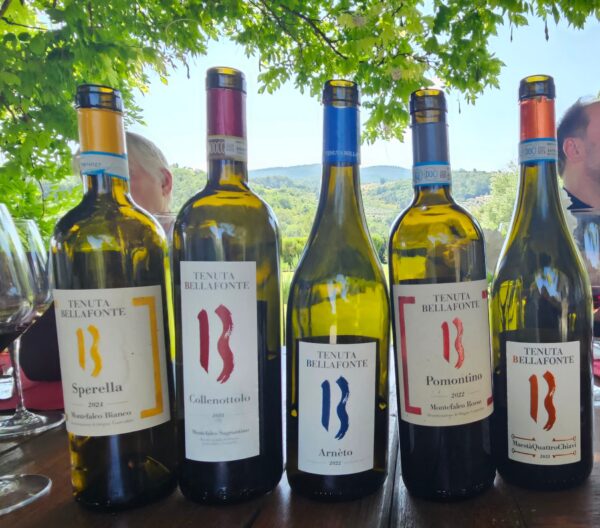
Wines we recommend:
Sperello Bianco 100% Trebbiano Spoletino DOC. Floral with a hint of cantaloupe
Arneto 2022 100% Trebbiano. A skin content white with notes of mango, peach, saffron
Pomontino Montefalco Rosso. made from 80% Sangiovese, 20% Sagrantino (black cherry, walnuts, sage and balsamic notes).
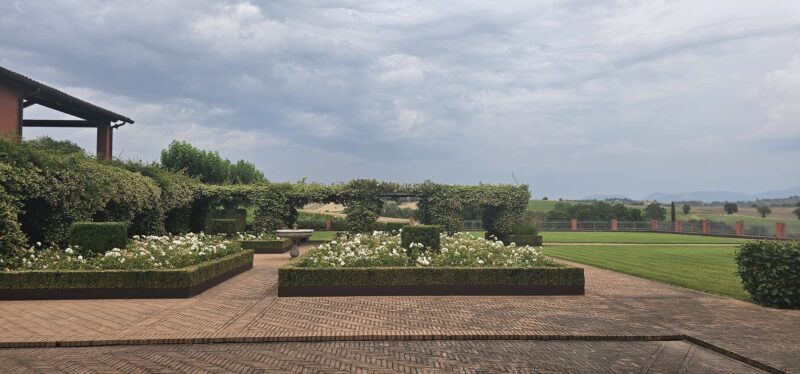
Gardens at Terre de la Custodia Photo: Melanie Young
Terre de La Custodia www.terredelacustodia.com
Rockabilly fans will immediately connect with Giampaolo Forchioni, who came out to greet us looking like he was ready to grab a guitar a start playing a tune for our group. Like his mother, Forchioni was also a competitive fencer. The Forchioni family’s fortune is in the grain business for cereals, flour and beer. The family started making wine in 1851 and today produces two million bottles. Over time and through marriage unions, the company grew and is now overseen by three generations of Forchioni family members; Giampolo is a grandson of the founders. The in-house winemaking is spearheaded by Marco Minciarelli, and famed Italian enologist Ricardo Cotarellla was initially retained as a consultant.
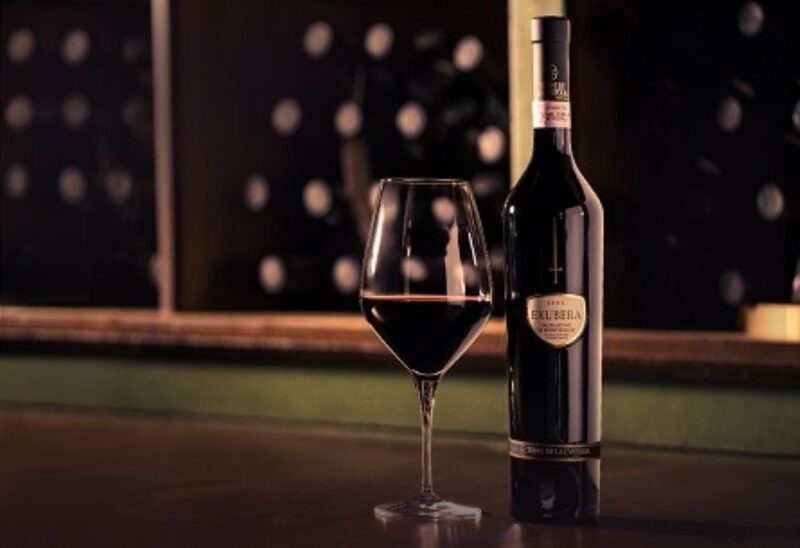
Terre de la Custodia Exubera Photo: La Strada del Sagrantino The Sagrantino Route.
Wines we recommend:
Gladius 2020 Metodo Classico, DOC Colli Montari sparkling wine that spends 48 months on lees.
Exubera Montefalco 2018 Sagrantino DOCG, a silky lush, balanced and less extracted of this wine that truly embraces that concept of “what is a contemporary Montefalco wine?” The indented bottle is patented and comes with a guitar pick. Terra de la Custodia also produces exceptional olive oils which we tasted with our dinner.
Melanto Passito 2o19 100% Sagrantino. A pleasant marriage of dark berries and spice.
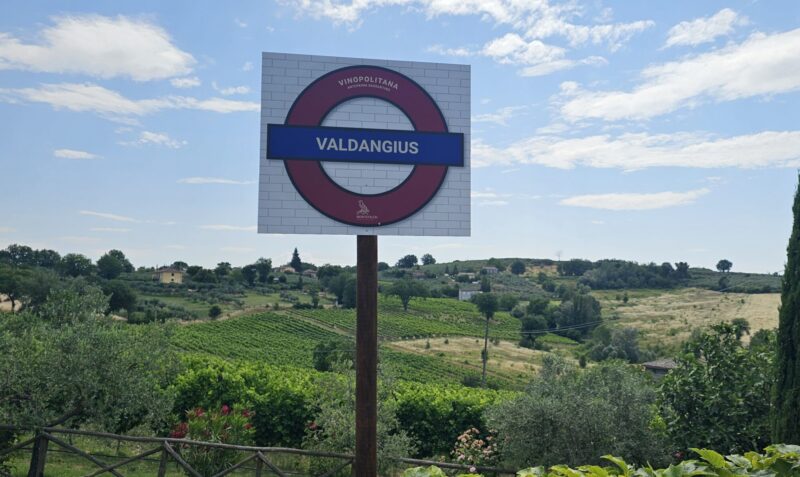
Photo: Melanie Young
Valdangius www.valdangius.it
Four generations of the Antonelli family have been making wine at Valdangius, which started selling bulk wine and turned to bottling under their own label in 2010. Now overseen by fourth generation family member, Danilo Antonelli, Valdangius produces limited production cru wines. Antonelli told us the calcareous-clay soils in this area known as San Marco “gives the wines their intensity, freshness and longevity.” Valdangius cultivates seven hectares, with red varieties (Sagrantino, Sangiovese, Merlot, Cabernet Sauvignon, Cabernet Franc) and white varieties (Trebbiano Spoletino, Chardonnay, Pecorino, Sauvignon Blanc). Starting with the 2025, all wines are certified organic.
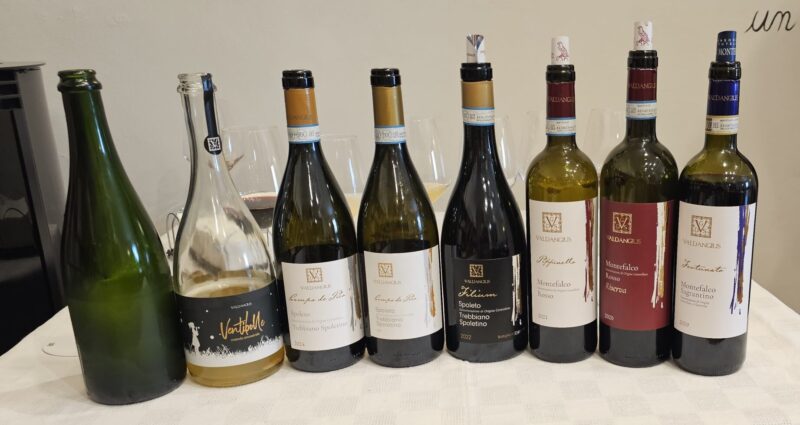
Wines we recommend:
Campo di Pico 2017 Trebbiano Spoletino. 13% Golden color from a hot vintage. Refined and austere with evolved fruit: marigold, mango, hazelnut, lemon.
Pipinello 2021 DOC Montefalco Rosso. 65% Sangiovese, 15% Sangrantino, 10% Cabernet Sauvignon, 10% Merlot. 5% ABV. Garnet color. Soft fruit – raspberry, cherry, strawberry, balanced tannins. Merlot and Cab Sauvignon add complexity and layers.
Fortunato 2019 Sagrantino di Montefalco DOCG, First vintage to partially vinify in amphora. Has more mineral notes and sapidity. Blackberry, cherry, plum, black olive, slightly salt on mid-back palate.
All of these wineries are members of the Consorzio Tutela Vini del Montefalco.
